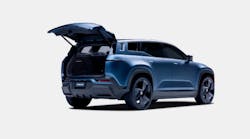Fisker Trims 2023 Production Goals, Delays Pear Production
After a rocky first quarter, Fisker Inc. executives have revised down their 2023 production goals, to between 32,000 and 36,000 units, a decline from the 42,400 they had expected in February. CFO Geeta Gupta-Fisker attributed the change to homologation work and issues with a Tier 1 supplier whose vendor went bankrupt.
“We resolved the release of our tools and our Tier 1 supplier has now confirmed that they will be able to meet our new forecasted volumes,” she said in the company's Q1 earnings call on Tuesday. “We’re actively working with those suppliers and our specialists and are managing these with Tier 1s to make sure we have no disruptions in our production schedule.”
Fisker made its first delivery of the long-awaited Ocean SUV in Denmark last week, with U.S. deliveries set to begin in late May. Further deliveries have allegedly been delayed due to software issues with the Ocean causing it to go slowly, although CEO Henrik Fisker vigorously denied the claim made in a Bloomberg story, saying he had driven the car at high speeds multiple times, even getting a speeding ticket.
“And now, of course, I told [the customer] I would also like [the ticket to be sent] to me, so I can post it online to show that the car actually is driving fairly fast, maybe sometimes faster than it should,” he said on the call. “It’s kind of sad that we need to be at this point in time, where they have to put speeding tickets online to refute such a ridiculous article."
Fisker has about 65,000 Ocean reservations on its books and recently completed certification for sale in Europe, with the U.S. “close behind.” It is currently produced by Magna International in Austria, and Gupta-Fisker said executives hope to produce 80 vehicles a week by the end of June and 1,400 to 1,700 total for Q2. From there, they expect a steep ramp in Q3 to a monthly run rate of 6,000.
The company also expects to introduce a new trim of the Ocean, Force E, which Henrik Fisker described as a “hard-core off-road package.” The trim will be available for everyone, even those who have already purchased their vehicle.
Executives also provided updates on Fisker’s second electric vehicle, the Pear, which currently has 6,000 reservations. Production will be delayed until the first half of 2025, as opposed to some time in 2024, and is planned to take place at Foxconn’s Northeast Ohio plant. It is expected to have a starting price of $29,900 and comprise approximately 25% fewer parts compared to the average EV. Henrik Fisker attributed the delay to moving to the United States for battery manufacturing so the Pear could qualify for $7,500 in tax incentives.
Financially, Fisker finished Q1 below analysts’ expectations with only $198,000 in revenue (compared to the $2.5 million expected) and a net loss of $121 million, about the same as its losses from the first three months of 2022. It ended the quarter with $652.5 million in cash.
Shares of Fisker (Ticker: FSR) dropped 13% after reporting earnings, opening at $5.75 and closed May 11 trading at $6.10. Over the last six months, Fisker stock has steadily declined 27% from a November high of $8.59, cutting the company’s market capitalization to $1.94 billion.




